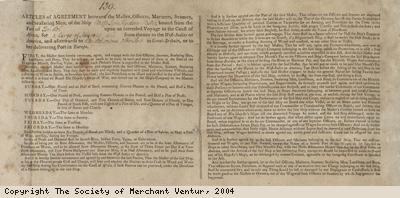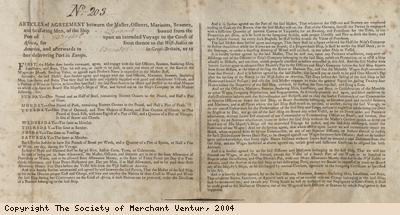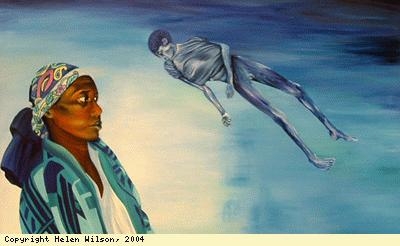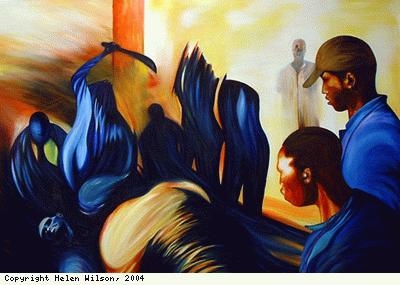Page 95 of 352 pages « First < 93 94 95 96 97 > Last »
Articles of Agreement

Description:
Ships’ muster rolls from 1794 – 1795; Society of Merchant Venturers’ archive.
Muster roll no: 139.
Articles of agreement for the ship, the Wasp , 1794.
The Wasp left Bristol with 28 crew. The master bought a reported 206 slaves at Bonny or New Calabar, over 2 months. 25 died before the Wasp left Africa. Another 25 died during the crossing to Jamaica.
Articles of agreement set out the terms and conditions of a voyage. The Articles was a standard printed form, listing the food rations and financial arrangements the crew would receive.
The muster roll is a list of all crew signed on for all or part of a voyage, which was used to calculate the money each man should pay to the Sailors’ Hospital Fund (insurance).
Date: 1794
Copyright: Copyright The Society of Merchant Venturers
Detail from muster roll

Description:
Ships’ muster rolls from 1794 – 1795; Society of Merchant Venturers’ archive.
Muster roll no: 14.
Detail from muster roll of the ship, the Brothers, 1793.
The cook on board, William Cary, was born in Africa, and was perhaps a free black seaman.
The muster roll is a list of all crew signed on for all or part of a voyage, which was used to calculate the money each man should pay to the Sailors’ Hospital Fund (insurance).
The Society of Merchant Venturers is a Bristol-based organisation, which was formed in 1552 as an elite body of merchants involved in overseas trade. The Society still exists today.
Date: 1793
Copyright: Copyright The Society of Merchant Venturers
Detail from muster roll

Description:
Ships’ muster rolls from 1793 – 1794; Society of Merchant Venturers’ archive.
Detail from muster roll no 203.
Detail from muster roll of the ship, The Levant.
Two crew were taken on in Calabar, in the Caribbean. One was from Exeter. The other was born in Calabar, and was perhaps a free black sailor.
The muster roll is a list of all crew signed on for all or part of a voyage, which was used to calculate the money each man should pay to the Sailors’ Hospital Fund (insurance).
The Society of Merchant Venturers is a Bristol-based organisation, which was formed in 1552 as an elite body of merchants involved in overseas trade. The Society still exists today.
Date: 1792
Copyright: Copyright The Society of Merchant Venturers
Articles of agreement

Description:
Ships’ muster rolls from 1793 – 1794; Society of Merchant Venturers’ archive.
Muster roll no: 203.
Articles of agreement for the ship, The Levant.
The Levant traded at New Calabar, West Africa, for a cargo of 348 slaves. 324 were sold at Jamaica.
Articles of agreement set out the terms and conditions of a voyage. The Articles was a standard printed form, listing the food rations and financial arrangements the crew would receive.
The muster roll is a list of all crew signed on for all or part of a voyage, which was used to calculate the money each man should pay to the Sailors’ Hospital Fund (insurance).
The Society of Merchant Venturers is a Bristol-based organisation, which was formed in 1552 as an elite body of merchants involved in overseas trade. The Society still exists today.
Date: 1792
Copyright: Copyright The Society of Merchant Venturers
Articles of agreement

Description:
Ships’ muster rolls from 1793 – 1794; Society of Merchant Venturers’ archive.
Muster roll no: 181.
Articles of agreement for the ship, The Prince.
The ship, the Prince, sailed for Africa for a cargo of Negroes with orders to buy 407. The actual number bought is not known, but 285 were sold at Jamaica. Several of the crew died of the fever and the flux.
Articles of Agreement set out the terms and conditions of a voyage. The Articles was a standard printed form, listing the food rations and financial arrangements the crew would receive.
The muster roll is a list of all crew signed on for all or part of a voyage, which was used to calculate the money each man should pay to the Sailors’ Hospital Fund (insurance).
The Society of Merchant Venturers is a Bristol-based organisation, which was formed in 1552 as an elite body of merchants involved in overseas trade. The Society still exists today.
The language used to describe people of African descent in the 18th, 19th and 20th centuries is unacceptable in today’s terms. We cannot avoid using this language in its original context. To change the words would impose 20th century attitudes on history.
Date: 1792
Copyright: Copyright The Society of Merchant Venturers
Note about muster roll

Description:
Ships’ muster rolls from 1793 – 1794; Society of Merchant Venturers’ archive.
Note about the muster roll for the ship, the Catherine no 201.
The Catherine was bound for Africa and Jamaica, but was taken by a French privateer on the first leg of the voyage to Africa. Hence this note in the muster roll books to say that no muster roll could be obtained.
The muster roll is a list of all crew signed on for all or part of a voyage, which was used to calculate the money each man should pay to the Sailors’ Hospital Fund (insurance).
The Society of Merchant Venturers is a Bristol-based organisation, which was formed in 1552 as an elite body of merchants involved in overseas trade. The Society still exists today.
Date: 1794
Copyright: Copyright The Society of Merchant Venturers
Detail, Four Avega Women, Helen Wilson

Description:
Detail from Four Avega Women , a painting by Helen Wilson.
To me, this is one of the most powerful paintings in the series. I wanted to paint more of the women I met, all of whom had AIDS and eight years on were still dying. I decided to paint just four of the women, much larger than life. These women live with the memories of watching their loved ones, children and grandchildren being raped and killed in the genocide, and the sense of loss makes it hard for them to go on living. The woman on the right is 92 years old and lost eleven children and grandchildren. Only one of the women is looking directly at us from the painting, as if judging the world for standing by and doing nothing to avert the tragedy. The AVEGA women wanted me to paint their stories as large as I could so the world would not forget.
Words of the artist.
AVEGA is the association of widows of the genocide, which works to improve the lives of women who have lost their husbands.
Helen Wilson is an artist who lives and works in Bristol.
In 2002, she visited Rwanda, where she met surviviors of the genocide in 1994.
Genocide means the planned or ordered killing of a racial or cultural group.
As a result of this visit, Helen returned,
…with a clear mission: to express through my artwork as much about Rwanda as it is today. I would paint the Rwanda I had seen, the beauty and the tragedy, and the dignity and grace of its people in the aftermath of the genocide.
These paintings formed a temporary display at the Bristol Museum and Art Gallery in 2003, called Making Sense – a Rwandan Story.
Copyright: Copyright Helen Wilson
Woman and Child, by Helen Wilson

Description:
Woman and Child , a painting by Helen Wilson.
This painting is based on a woman I met in the AVEGA village of Kimironko. There were twenty women in the room. This womans eyes caught my attention. Her expression did not change and her eyes told a very tragic story. She told me that she had been raped and lost seven children. The woman had AIDS and was waiting to die. She said that she was looking forward to dying and joining her family. She believed that she would be re-united with her children. The child in the painting is not her son (I did not have a picture of him). The image is inspired by a photograph in Gilles Peress book The Silence of a dead child covered with lime lying on a rubbish dump. Although the woman is not looking at the child, there is a connection betwen the two.
AVEGA is the association of widows of the genocide, which works to improve the lives of women who have lost their husbands.
Helen Wilson is an artist who lives and works in Bristol.
In 2002, she visited Rwanda, where she met surviviors of the genocide in 1994.
Genocide means the planned or ordered killing of a racial or cultural group.
As a result of this visit, Helen returned,
…with a clear mission: to express through my artwork as much about Rwanda as it is today. I would paint the Rwanda I had seen, the beauty and the tragedy, and the dignity and grace of its people in the aftermath of the genocide.
These paintings formed a temporary display at the Bristol Museum and Art Gallery in 2003, called Making Sense – a Rwandan Story.
Creator: Helen Wilson
Date: 2003
Copyright: Copyright Helen Wilson
Genocidaires, by Helen Wilson

Description:
Genocidaires , a painting by Helen Wilson.
This painting is based on a still from the feature film 100 Days, directed by Nick Hughes. I saw the still in the East African newspaper I bought when I arrived in Rwanda. The image I have painted sums up the horror I felt when coming back from the genocide sites. The particular act of killing shown in the picture took place in Nyamata Church, where 20,000 people died. The brush strokes and colours suggest extreme violence, and I wanted to capture the sheer hell and inhumanity of what went on. I did not witness the genocide, I witnessed its aftermath. However, visiting the church gave me a sense of the wanton destruction of human life. The painting has three elements. Firstly, the madness of the violence which we see in the frenzied killing on the left of the picture. We cannot see clearly what is depicted, but we see the machete raised and know that people are being murdered. Secondly, the two figures on the right hand side represent people who watched their families being slaughtered, some of whom had to participate in the killing. The third element is the spectre-like figure in the background, which represents the world watching and knowing what is going on, but choosing to do nothing.
Words of the artist.
Helen Wilson is an artist who lives and works in Bristol.
In 2002, she visited Rwanda, where she met surviviors of the genocide in 1994.
Genocide means the planned or ordered killing of a racial or cultural group.
As a result of this visit, Helen returned,
…with a clear mission: to express through my artwork as much about Rwanda as it is today. I would paint the Rwanda I had seen, the beauty and the tragedy, and the dignity and grace of its people in the aftermath of the genocide.
These paintings formed a temporary display at the Bristol Museum and Art Gallery in 2003, called Making Sense – a Rwandan Story.
Creator: Helen Wilson
Date: 2002-3
Copyright: Copyright Helen Wilson
Notice: tobacco and snuff business

Description:
From Bonner and Middleton’s Bristol Journal.
Notice regarding a tobacconist and snuff-making business in Bristol.
Date: July 7th 1781
Copyright: Copyright BCC Library Service

